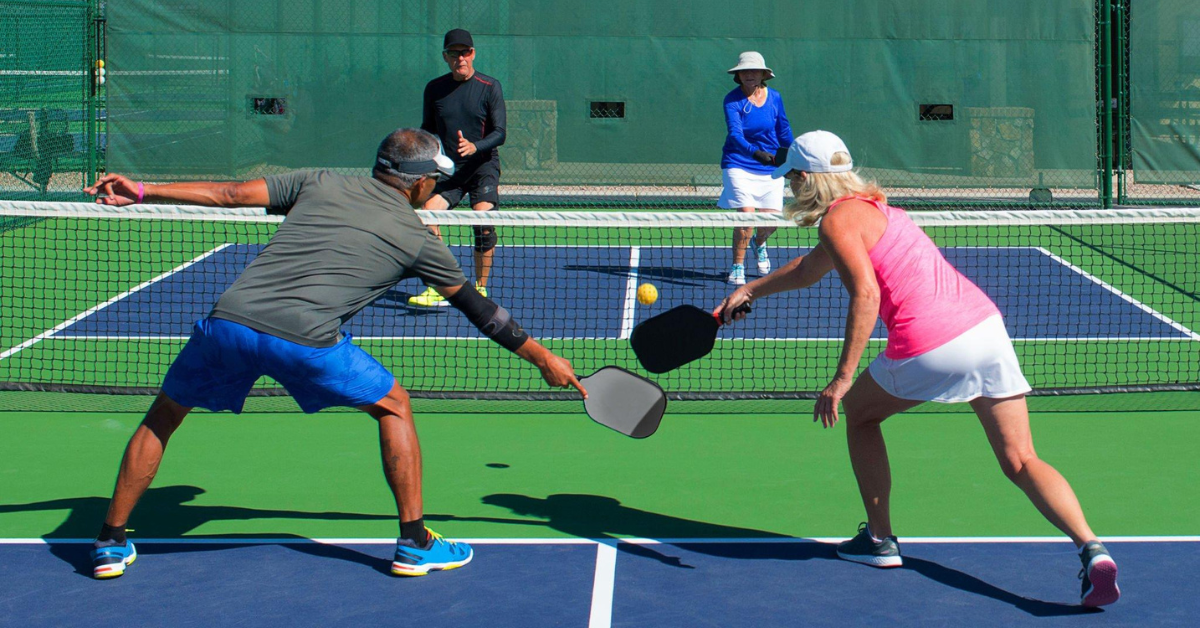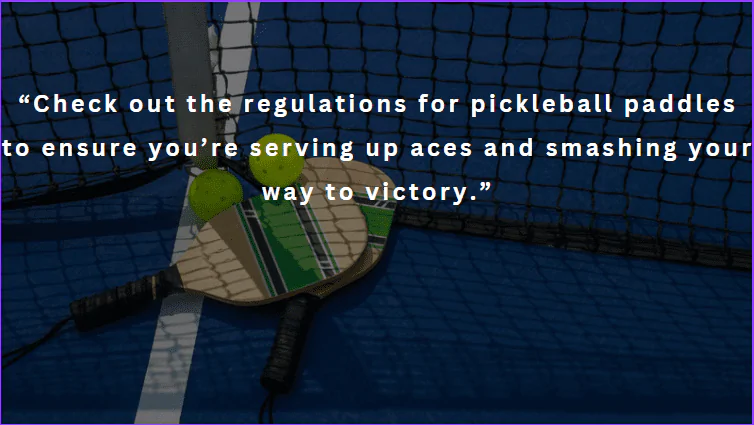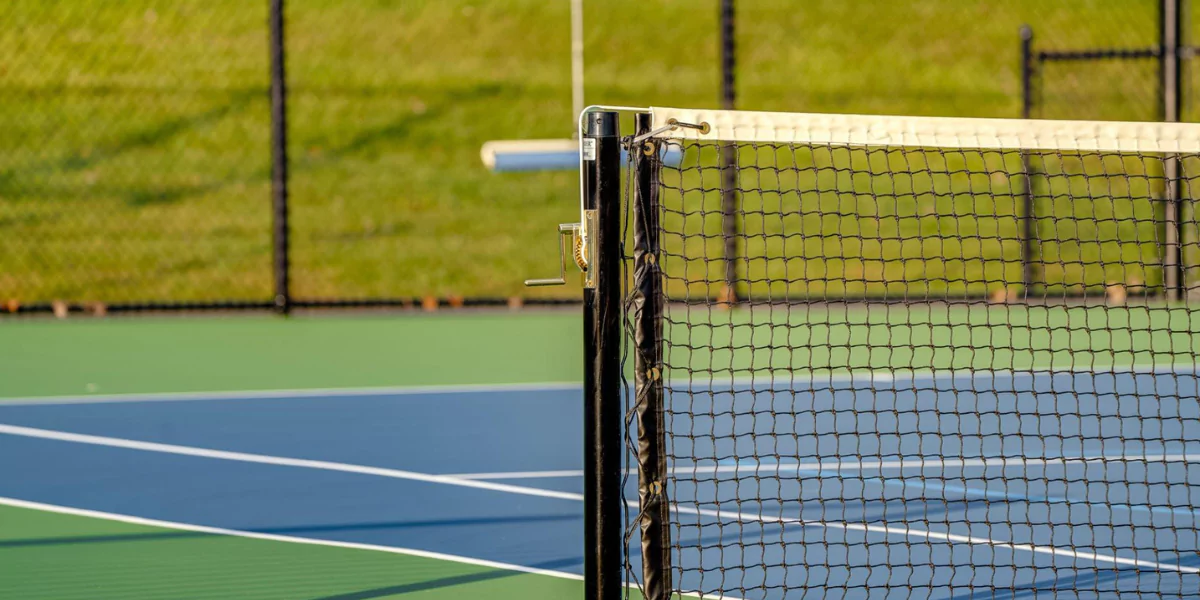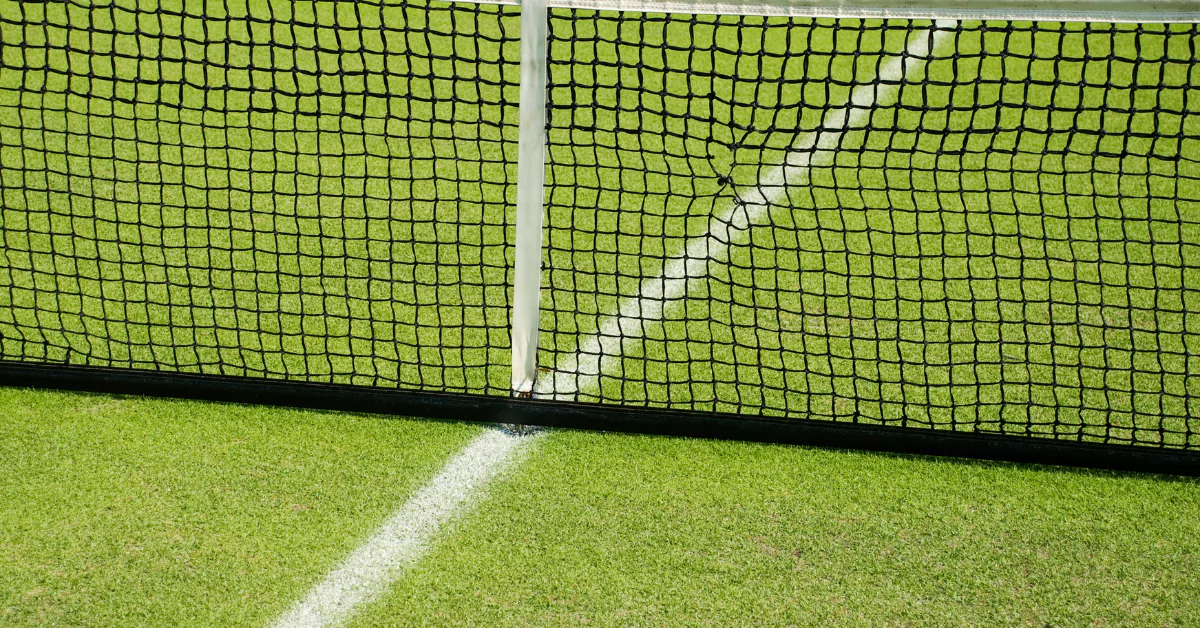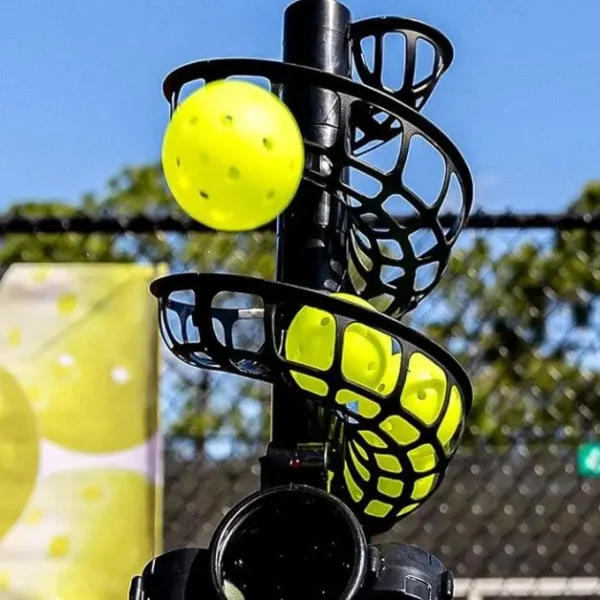Pickleball Mixed Doubles Strategy
In this article, we will focus on the mixed doubles format, where a male and a female partner up to play against another pair of the opposite gender.
Mixed doubles pickleball is different from regular doubles pickleball in many ways. The partners have to work together to complement each other’s strengths and weaknesses, and they have to face different challenges and opportunities depending on their opponents’ gender, style, and skill level. In this article, we will explore some of the best strategies and tips for playing mixed doubles pickleball, as well as some common mistakes to avoid. We will cover the following topics:
Third Shot Strategies in Mixed Doubles
The third shot is one of the most important shots in pickleball, especially in mixed doubles. The third shot is the first shot that the serving team hits after the return of serve. The goal of the third shot is to neutralize the advantage that the receiving team has by being at the net, and to allow the serving team to transition from the baseline to the kitchen line.
There are two main types of third shots: the drop shot and the drive shot. The drop shot is a soft shot that lands near the kitchen line, forcing the opponents to hit up on the ball. The drive shot is a hard shot that goes low over the net, challenging the opponents’ reflexes and volleys. Both shots have their pros and cons, and choosing which one to use depends on several factors, such as:
- The position and skill level of your opponents
- The position and skill level of your partner
- The angle and speed of the return of serve
- The wind and sun conditions
- Your personal preference and confidence
In general, the drop shot is more effective when your opponents are at or near the net, as it makes them move back and hit up on the ball. The drive shot is more effective when your opponents are at or near the baseline, as it makes them move forward and hit down on the ball. However, there are exceptions to these rules, and sometimes you may want to mix up your shots to keep your opponents guessing.
In mixed doubles, there are some additional considerations for choosing your third shot. For example:
- If you are playing against a weaker female opponent, you may want to target her with your third shot, either with a drop shot or a drive shot, depending on her position and skill level.
- If you are playing against a stronger male opponent, you may want to avoid him with your third shot, either by hitting crosscourt to his female partner or by hitting down the middle between them.
- If you are playing with a weaker female partner, you may want to protect her with your third shot, either by hitting crosscourt to draw away her male opponent or by hitting down the middle to create confusion between them.
- If you are playing with a stronger male partner, you may want to set him up with your third shot, either by hitting crosscourt to his forehand side or by hitting down the middle to his backhand side.
Of course, these are not hard-and-fast rules, and you should always adapt your strategy according to the situation and your opponents’ reactions. The key is to communicate with your partner before and during the game, and to practice different scenarios with different types of third shots.
Mixed Doubles in Pickleball: Ball Hog or Good Strategy?
In mixed doubles pickleball play—particularly high-level, competitive mixed doubles play ( *to note, this pickleball blog focuses on very common patterns of play at high-level, competitive pickleball (e.g. pro pickleball), and certainly does not speak to every mixed doubles pickleball play or match-up )—one partner will oftentimes step across the centerline and take shots on his/her partner’s “side” of the pickleball court. Speaking by the percentages in high-level pickleball, this is usually the male stepping across into his partner’s side of the pickleball court. In fact, sometimes, the male partner will take 75% of the pickleball court. As an unknowing bystander, it can be easy to think that the male partner is being a “ball hog” or taking his female partner’s shots. However, this actually may not be the case. In fact, this can be good pickleball strategy.
The goal on the pickleball court in competitive play is to apply as much pressure on your opponents as possible. To apply pressure, there are two general things to focus on:
(1) whichever partner can hit the best shot and apply the most pressure on the pickleball at that time should take the shot; and (2) the shot should be hit at the opponent who is weaker at handling the pressure at that time.
While this is not always true, oftentimes (particularly in competitive play), this means that
(1) the partner on the pickleball court with the greater size, reach, and power will hit the pickleball (stereotypically, this would be the male partner, but, again, this is not always the case); and (2) the shot should be hit at the weaker opponent, who would have more trouble handling the consistent pressure (stereotypically, this would be the female partner, but, again, this is not always the case).
As a result, there are some similar patterns that occur in high-level, competitive mixed doubles pickleball play (for instance, the pro pickleball level)—particularly when at the kitchen line. These similar patterns are:
- Assuming that the male partner is a right-handed player, the female partner will play the even/right-hand side of the pickleball court, and the male partner will play the odd/left-hand side of the pickleball court. This will make it easier for the male partner to insert himself into the point, as his forehand will be toward the middle of the pickleball court.
- The female players on the pickleball court will oftentimes hit most of the shots on the pickleball court, as they are the common targets. As a result, these female players may fall into a crosscourt dink battle. If you find yourself as one of these female players, expect to be the target and expect to be the target of all attacks and offensive shots. Also, expect to find yourself in a crosscourt dink battle. If so, be sure to remain patient. Although you may want to stay in the crosscourt dink with your female counterpart, don’t forget to move the pickleball around in the crosscourt dink.
So, is it a ball hog or good strategy for one partner to take most of the shots on his/her partner’s side of the pickleball court? The answer is: it depends. It depends on whether the partner taking most of the shots is doing so for strategic reasons or for selfish reasons. It also depends on whether the partner taking most of the shots is actually hitting good shots that apply pressure on the opponents or bad shots that give away points. And it also depends on whether the partner taking most of the shots is communicating with his/her partner and respecting his/her wishes.
If you are playing mixed doubles pickleball and you find yourself in a situation where your partner is taking most of your shots, here are some tips to handle it:
- Talk to your partner before and during the game. Ask him/her why he/she is taking your shots and what his/her strategy is. Explain how you feel about it and what you prefer. Try to reach a mutual understanding and agreement.
- Trust your partner’s judgment and skill. If he/she is taking your shots because he/she thinks he/she can hit a better shot and apply more pressure on your opponents, then let him/her do it. He/she may have a good reason and a good plan.
- Support your partner’s shots and movements. If he/she is taking your shots, then you should adjust your position and cover his/her side of the court. You should also compliment his/her good shots and encourage him/her after bad shots.
- Don’t take it personally or get frustrated. Remember that your partner is not trying to offend you or undermine you. He/she is trying to help you win as a team. Don’t let your ego get in the way of your teamwork.
Mixed Doubles Pickle Ball: Strategies to Win The Game
Pickle ball is a game that requires both skill and strategy to win. In mixed doubles pickle ball, where you have to play with a partner of the opposite gender, strategy becomes even more important. Here are some strategies that can help you win more games in mixed doubles pickle ball:
- Know your partner’s strengths and weaknesses. Before you start playing with a new partner, try to find out what his/her strengths and weaknesses are. For example, does he/she have a strong forehand or backhand? Does he/she have a good serve or return? Does he/she like to play aggressively or defensively? Does he/she have any weaknesses that you need to cover or avoid? Knowing these things can help you plan your strategy and coordinate your moves with your partner.
- Communicate with your partner. Communication is key in any team sport, and pickle ball is no exception. You and your partner should talk to each other before and during the game, and give each other feedback and encouragement. You should also use signals or code words to indicate your intentions and expectations. For example, you can say “switch” if you want to change sides with your partner, or “yours” if you want your partner to take the shot. You can also use hand gestures or eye contact to communicate non-verbally. Communication can help you avoid confusion and conflicts, and improve your teamwork and performance.
- Play to your strengths and exploit your opponents’ weaknesses. Once you know your partner’s and your opponents’ strengths and weaknesses, you can use them to your advantage. For example, if your partner has a strong forehand and your opponent has a weak backhand, you can try to hit the ball to your partner’s forehand side and make him/her hit crosscourt to your opponent’s backhand side. This way, you can put pressure on your opponent and create opportunities for yourself. On the other hand, if your partner has a weak backhand and your opponent has a strong forehand, you can try to avoid hitting the ball to your partner’s backhand side and make him/her hit down the line to your opponent’s forehand side. This way, you can reduce the risk of giving away easy points.
- Be flexible and adaptable. Pickle ball is a dynamic game that can change quickly depending on the situation. You and your partner should be ready to adjust your strategy and tactics according to the circumstances. For example, if you notice that your opponents are playing more defensively or offensively than usual, you can change your pace and style accordingly. If you notice that your opponents are targeting one of you more than the other, you can switch sides or positions to balance the pressure. If you notice that your opponents are using a different shot or technique than before, you can try to counter it or copy it. Being flexible and adaptable can help you surprise your opponents and gain an edge over them.
- Have fun and enjoy the game. Last but not least, remember that pickle ball is a game that is meant to be fun and enjoyable. You and your partner should have a positive attitude and a good sportsmanship throughout the game. You should respect your opponents and the rules of the game, and avoid arguing or complaining. You should also celebrate your wins and learn from your losses, and always look for ways to improve yourself and your partner. Having fun and enjoying the game can help you relax and perform better, as well as make new friends and have a good time.
Pickleball Mixed Doubles: Two Young Teams, Two Totally Different Strategies!
Pickleball mixed doubles is a fascinating game that showcases different styles and strategies of play. In this section, we will analyze two young teams that played against each other in a recent tournament, and how they used two totally different strategies to compete.
The first team consisted of Ben Johns (age 23) and Simone Jardim (age 41), who are both considered among the best pickleball players in the world. They played with an aggressive and dominant strategy, where Ben Johns took most of the shots on the court, especially on his partner’s side. He used his power, speed, reach, and skill to hit hard drives, overheads, volleys, lobs, spins, angles, and drop shots that put pressure on their opponents. He also moved around the court quickly and confidently, covering his partner’s side and leaving her with little space. Simone Jardim played a supportive role, where she mostly stayed on her side of the court, hitting soft dinks or defensive shots when needed. She also communicated with her partner well, giving him signals or words of encouragement. She also complimented his shots and celebrated their points.
The second team consisted of Anna Leigh Waters (age 14) and JW Johnson (age 19), who are both rising stars in the pickleball world. They played with a balanced and cooperative strategy, where they shared the shots on the court equally, depending on who had the better angle or opportunity. They used their finesse, consistency, patience, and creativity to hit soft dinks, lobs, spins, angles, drop shots, drives, and volleys that moved their opponents around. They also moved around the court smoothly and synchronously, switching sides or positions when needed. They communicated with each other well, using signals or code words to indicate their intentions or expectations. They also encouraged each other and celebrated their points.
The match was a close and exciting one, with both teams displaying high-level pickleball skills and strategies. The final score was 11-9, 11-9 in favor of Ben Johns and Simone Jardim. They won by using their aggressive and dominant strategy, where Ben Johns took charge of the game and hit powerful and precise shots that overwhelmed their opponents. However, Anna Leigh Waters and JW Johnson also put up a great fight, by using their balanced and cooperative strategy, where they played as a team and hit smart and creative shots that challenged their opponents.
The match showed that there is no one right way to play pickleball mixed doubles, and that different strategies can work for different teams. The key is to find the strategy that suits your partner’s and your own strengths and weaknesses, and to execute it well. It also showed that pickleball mixed doubles is a fun and exciting game that can be played by people of different ages, genders, and skill levels.
Pickleball Mixed Doubles Serving Strategy
Serving is one of the most important skills in pickleball, as it starts every point and sets the tone for the rally. In mixed doubles pickleball, serving strategy becomes even more important, as you have to consider not only your own serve, but also your partner’s serve and your opponents’ return. Here are some tips on how to serve effectively in mixed doubles pickleball:
Understand the basics of serving in pickleball mixed doubles.
The basic rules of serving in pickleball mixed doubles are:
- You must serve underhand, with your paddle below your waist and the ball below your navel.
- You must hit the ball in the air, without bouncing it on the ground.
- You must serve diagonally, from your right-hand service court to your opponent’s right-hand service court when the score is even, and from your left-hand service court to your opponent’s left-hand service court when the score is odd.
- You must serve within the boundaries of the court, without hitting the net or the non-volley zone (also known as the kitchen).
- You have only one serve attempt per point, unless you hit a let (a serve that touches the net but lands in the correct service court), in which case you can serve again.
- You and your partner can only serve once per side-out (a change of possession), unless you score a point on your first serve, in which case you can serve again from the other service court.
Strategic placement of serves.
The placement of your serve can make a big difference in how your opponents return it and how you and your partner can attack it. Some of the factors that affect the placement of your serve are:
- The position and skill level of your opponents. You should try to serve to the weaker or less prepared opponent, or to the weaker or less preferred side of your opponent (usually the backhand side). You should also try to serve to the corner or sideline of the service court, to make your opponent move more and hit at an angle.
- The position and skill level of your partner. You should try to serve to set up your partner for a good third shot (the first shot that the serving team hits after the return of serve). For example, if your partner has a strong forehand and likes to hit crosscourt drop shots, you should try to serve from the odd/left-hand service court to your opponent’s odd/left-hand service court, so that your partner can hit a forehand crosscourt drop shot on the third shot.
- The wind and sun conditions. You should try to serve with the wind or sun behind you, or across you, rather than against you or in front of you. This will make it easier for you to control your serve and harder for your opponent to see or return it.
Variety of serves.
The variety of your serve can keep your opponents guessing and off balance. You can vary your serve by changing its speed, spin, height, depth, angle, or direction. Some examples of different types of serves are:
- The power serve. This is a fast and hard serve that goes low over the net and deep into the service court. It is designed to challenge your opponent’s reflexes and volleys, and to force a weak or high return that you or your partner can attack. However, it also has some drawbacks, such as being more prone to errors, being affected by the wind, and giving your opponent more time to get to the net.
- The spin serve. This is a serve that has either topspin or backspin, or a combination of both, that makes the ball bounce unpredictably or differently than a normal serve. It is designed to confuse your opponent and make him/her miss or mishit the return. However, it also has some drawbacks, such as being harder to execute, being less effective on soft or rough surfaces, and being easier to read by experienced players.
- The lob serve. This is a high and deep serve that goes over your opponent’s head and lands near the baseline. It is designed to make your opponent move back and hit up on the ball, and to give you and your partner more time to get to the net. However, it also has some drawbacks, such as being vulnerable to overhead smashes, being affected by the sun, and giving your opponent more time to recover.
- The drop serve. This is a soft and short serve that lands near the kitchen line. It is designed to make your opponent move forward and hit down on the ball, and to catch him/her off guard. However, it also has some drawbacks, such as being risky, being easy to attack if not executed well, and giving you and your partner less time to get to the net.
Consistency of serves.
The consistency of your serve can make a big difference in how many points you win or lose in a game. You should try to avoid making serving errors, such as hitting the net, hitting out of bounds, hitting the non-volley zone, or missing the correct service court. You should also try to avoid making weak or predictable serves that give your opponents an easy return or an advantage in the rally. You should practice your serve regularly and improve your accuracy and confidence.
Final Words
Pickleball mixed doubles is a fun and challenging game that requires both skill and strategy to win. By following the tips and strategies in this article, you can improve your game and enjoy it more with your partner. Remember that pickleball mixed doubles is also a game of teamwork and communication, so you should always respect and support your partner, as well as your opponents. Have fun and play pickleball!
Frequently Asked Questions (FAQ) on Pickleball Mixed Doubles Strategy
Is it allowed to bounce the ball before serving in pickleball?
No, it is not allowed to bounce the ball before serving in pickleball. You must hit the ball in the air without bouncing it on the ground. This is one of the main differences between pickleball and tennis serving rules.
How can I improve the power and accuracy of my serves?
There are several ways to improve the power and accuracy of your serves, such as:
- Use a proper grip. You should use a continental grip (also known as a hammer grip), where you hold the paddle like you are shaking hands with it. This will allow you to hit different types of serves with ease.
- Use a proper stance. You should stand with your feet shoulder-width apart, with your front foot pointing toward your target and your back foot slightly behind and parallel to it. This will give you balance and stability.
- Use a proper swing. You should swing your paddle from low to high, with a smooth and fluid motion. You should also follow through with your swing, pointing your paddle toward your target.
- Use a proper contact point. You should hit the ball at its highest point, with the center of your paddle face. This will give you more control and consistency.
- Use a proper toss. You should toss the ball slightly in front of you and above your waist level. This will give you more time and space to hit the ball.
Which side should I serve from in pickleball mixed doubles?
You should serve from the right-hand service court when the score is even (0-0, 2-2, 4-4, etc.), and from the left-hand service court when the score is odd (1-1, 3-3, 5-5, etc.). This rule applies to both you and your partner.
Can I add topspin to a pickleball serve, and how?
Yes, you can add topspin to a pickleball serve by hitting the ball with an upward brushing motion with your paddle face slightly tilted forward. This will make the ball spin forward and bounce higher after landing. To add more topspin, you can increase the speed and angle of your swing.

